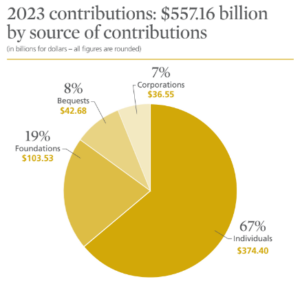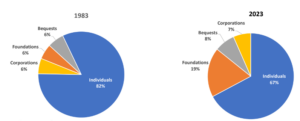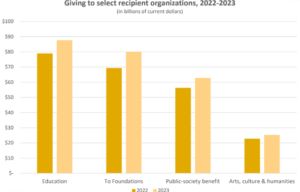 By Joshua Meyer, VP of Market Engagement for Bloomerang
By Joshua Meyer, VP of Market Engagement for Bloomerang
The 2023 Giving USA report told the story of a challenging fundraising environment after a monumental boost during the peak years of the pandemic. The 2024 report reveals that total charitable giving remained relatively stable while other key trends emerged, from changes in giving for each sector to shifting donor priorities.
So, how does this impact your nonprofit’s strategies this year? Let’s dive into the numbers to reveal the top takeaways from Giving USA 2024 and actionable next steps to take at your organization based on these findings.
1. Total estimated charitable giving in the U.S. reached $557.16 billion.

Source: Giving USA 2024
This is a giving high in current dollars. However, total giving did not outpace inflation—it declined 2.1% when adjusted for inflation. Total giving has yet to top the all-time high of 2021.
In addition, average online revenue declined 1% in 2023, according to the M+R Benchmarks study. Nevertheless, the study found that revenue from monthly giving rose by 6%, accounting for 31% of all online revenue in 2023 (up from 27% in 2022).
Donors who contribute ongoing monthly gifts can provide a greater lifetime value than supporters who give just once or sporadically. This is a reliable fundraising avenue to consider as the nonprofit sector weathers fluctuations in total giving.
To foster greater recurring giving among your audience, take the following simple steps:
- Provide a clear monthly giving option on your online donation page.
- Demonstrate the impact of monthly giving by sharing stories and data with prospective donors. For example, you could share a story about how your monthly giving program helps provide food for families in need.
- Spotlight the benefits of joining your monthly giving program, such as access to exclusive events or free merchandise.
2. Giving by individuals declined by 2.4% in 2023 (when adjusted for inflation).
Giving by individuals is shrinking as a piece of the total giving pie. This phenomenon reflects uncertain economic circumstances, including rising inflation, which peaked at the end of 2022 and remained relatively high at the beginning of 2023 before declining.
However, as giving by individuals shrinks, giving by foundations is growing. Giving by foundations experienced market growth in four of the past five years and significant growth over the past 40 years.

Source: Lilly Family School of Philanthropy
What do these numbers mean for your nonprofit’s strategy? We recommend taking the following steps to adapt to evolving circumstances surrounding individual and foundation giving:
- Personalize the donor experience. Use your nonprofit’s donor management system to personalize supporter outreach with donors’ names and references to their past involvement, whether donations, volunteer support, or other forms of engagement. This personalization shows you care about donors as individuals and may entice them to contribute.
- Provide multiple ways to give. Give supporters a variety of giving options so they can choose the opportunities that best align with their charitable goals and giving capacity. In addition to direct donations, popular forms of giving include in-kind gifts, gifts of stock, and donations via digital wallet or cryptocurrency.
- Promote DAFs as a top giving option. Donor-advised funds (DAFs) in particular are picking up speed as a popular giving method for high-value donors and foundations. Prompt donors and foundations to contribute DAF funds to your nonprofit by including information about the impact of these gifts in your fundraising outreach, including letters and emails.
- Apply for relevant grants. Many organizations approach grant-seeking as a simple numbers game—the more grant proposals you send, the more grants you’ll win. But it’s equally important to choose grant opportunities strategically. This means finding grant funders whose goals and priorities align with your nonprofit’s and taking the time to complete each grant application thoroughly and thoughtfully.
3. Several sectors saw major boosts in giving.
Giving to each of these sectors grew by more than 5% in 2023 (when adjusted for inflation):
- Education grew by 6.7%.
- Foundations grew by 10.8%.
- Public-society benefit grew by 7.2%.
- Arts, culture, and humanities grew by 6.6%.

Source: Lilly Family School of Philanthropy
These segments coincide with common giving priorities of the wealthiest donors. With that in mind, we recommend taking this opportunity to refine your major giving program by taking the following steps:
- Understand the shifting demographics of major donors. The average age at which major donors make their first large gift has increased from 55 to 66 years over the past two decades. Older donors tend to gravitate toward face-to-face communication methods. They also tend to take their time to research the causes they care about and ensure they make wise decisions about where to direct their philanthropic giving. Keep these preferences in mind as you build relationships with prospective major donors.
- Leverage prospect research and wealth screening to connect with more major donors. Bloomerang’s nonprofit software guide points to prospect research software as an effective way to identify supporters with “the capacity and willingness to make a major gift to your organization.” These solutions can help screen potential major donors to identify your most likely prospects and reach out to them with personalized messages.
4. Bequests continue to be significant.
Giving by bequest stayed relatively flat this year but remains a significant piece of the puzzle of total giving. Bequests represent around 8-10% of total giving over the last 40 years. In 2023, giving by bequest totaled $42.68 billion, remaining at a relatively flat growth rate of 0.6%.
To make the most of this trend, incorporate giving by bequest as an option for your donors. Promote this opportunity using these strategies:
- Don’t overlook small or mid-sized donors. Planned giving research shows that many organizations receive significant portions of their legacy gifts from non-major donors and even people who have never donated. Therefore, you shouldn’t overlook small and mid-sized donors in your planned giving strategy, as these individuals may be well-positioned to make a larger gift.
- Explain the benefits of this type of giving, such as having the ability to create a legacy. Show donors how they can have an enduring impact on a cause they’re passionate about. For example, you could demonstrate how scholarships funded by bequests help students achieve their academic goals.
- Include information on your website about giving by bequest. Let donors know how to register for informational meetings about your planned giving program or join your legacy giving society. Provide details about how donors can work with their attorneys to prepare the necessary documents to contribute bequests.
5. Corporate giving is a small but growing piece of the pie.
The five-year growth rate for corporate giving is 14.3%—over twice the total giving rate over the same period (5.3%).
Corporate philanthropy is growing as more companies offer a wide range of giving opportunities for their employees. According to research from Double the Donation, more small and mid-sized companies are getting involved in corporate philanthropy, and businesses are adopting more employee-driven corporate giving programs, like matching gifts.
You can build stronger corporate relationships by making an effort to:
- Form partnerships with corporate sponsors. Identify two or three businesses with which you could form long-term partnerships for mutual benefit. The most reliable corporate partnerships are built on mutual trust and shared values. For example, if your nonprofit seeks to preserve the local environment, you might partner with a local outdoor gear and clothing business that prioritizes sustainability in its corporate goals.
- Find new ways to engage corporate donors. Corporate support doesn’t have to just come in the form of direct monetary donations. Ask corporate donors for in-kind donations to support events like silent auctions. Or, plan recurring corporate volunteer days with team-building activities. Essentially, give corporate sponsors new and engaging ways to support your mission that align with their giving capacity and interests.
Building a resilient nonprofit requires adapting to shifting circumstances and trends in the philanthropic giving space. Take the insights from this year’s Giving USA report to adapt your nonprofit’s strategies by prioritizing strong donor relationships and revenue streams like grants, bequests, and corporate giving.


